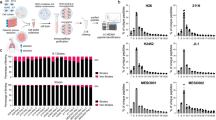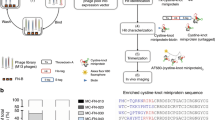Abstract
Blood vessels of tumors carry specific markers that are usually angiogenesis-related1,2. We previously used phage-displayed peptide libraries in vivo to identify peptides that home to tumors through the circulation and that specifically bind to the endothelia of tumor blood vessels3,4. Here we devised a phage screening procedure that would favor tumor-homing to targets that are accessible to circulating phage, but are not blood vessels. Screening on MDA-MB-435 breast carcinoma xenografts yielded multiple copies of a phage that displays a cyclic 9-amino-acid peptide, LyP-1. Homing and binding to tumor-derived cell suspensions indicated that LyP-1 also recognizes an osteosarcoma xenograft, and spontaneous prostate and breast cancers in transgenic mice, but not two other tumor xenografts. Fluorescein-labeled LyP-1 peptide was detected in tumor structures that were positive for three lymphatic endothelial markers and negative for three blood vessel markers. LyP-1 accumulated in the nuclei of the putative lymphatic cells, and in the nuclei of tumor cells. These results suggest that tumor lymphatics carry specific markers and that it may be possible to specifically target therapies into tumor lymphatics.
This is a preview of subscription content, access via your institution
Access options
Subscribe to this journal
Receive 12 print issues and online access
$209.00 per year
only $17.42 per issue
Buy this article
- Purchase on Springer Link
- Instant access to full article PDF
Prices may be subject to local taxes which are calculated during checkout



Similar content being viewed by others
Change history
01 July 2002
The supplementary info pieces that originally went up with the aop had incorrect figure legends. Editorial Production supplied new pieces and we put them up with the July issue.
References
Hanahan, D. & Folkman, J. Patterns and emerging mechanisms of the angiogenic switch during tumorigenesis. Cell 86, 353–364 (1996).
Ruoslahti, E. Specialization of tumour vasculature. Nature Rev. Cancer 2, 83–90 (2002).
Arap, W., Pasqualini, R. & Ruoslahti, E. Cancer treatment by targeted drug delivery to tumor vasculature in a mouse model. Science 279, 377–380 (1998).
Porkka, K., Laakkonen, P., Hoffman, J.A., Bernasconi, M. & Ruoslahti, E. A fragment of the HMGN2 protein homes to the nuclei of tumor cells and tumor endothelial cells in vivo. Proc. Natl. Acad. Sci. USA (in the press).
Hoffman, J.A., Laakkonen, P., Porkka, K., Bernasconi, M. & Ruoslahti, E. In vivo and ex vivo selections using phage-displayed libraries. in Phage Display: A Practical Approach (eds. Clackson, T. & Lowman, H.) (Oxford University Press, Oxford, UK, in the press).
Oliver, G. & Detmar, M. The rediscovery of the lymphatic system: old and new insights into the development and biological function of the lymphatic vasculature. Genes Dev. 16, 773–783 (2002).
Makinen, T. et al. Isolated lymphatic endothelial cells transduce growth, survival and migratory signals via the VEGF-C/D receptor VEGFR-3. EMBO J. 20, 4762–4773 (2001).
Chang, Y.S. et al. Mosaic blood vessels in tumors: frequency of cancer cells in contact with flowing blood. Proc. Natl. Acad. Sci.USA 97, 14608–14613 (2000).
Jackson, D.G., Prevo, R., Clasper, S. & Banerji, S. LYVE-1, the lymphatic system and tumor lymphangiogenesis. Trends Immunol. 22, 317–321 (2001).
Prevo, R., Banerji, S., Ferguson, D.J., Clasper, S. & Jackson, D.G. Mouse LYVE-1 is an endocytic receptor for hyaluronan in lymphatic endothelium. J. Biol. Chem. 276, 19420–19430 (2001).
Breiteneder-Geleff, S. et al. Angiosarcomas express mixed endothelial phenotypes of blood and lymphatic capillaries: Podoplanin as a specific marker for lymphatic endothelium. Am. J. Pathol. 154, 385–394 (1999).
Kubo, H. et al. Involvement of vascular endothelial growth factor receptor-3 in maintenance of integrity of endothelial cell lining during tumor angiogenesis. Blood 96, 546–553 (2000).
Stacker, S.A. et al. VEGF-D promotes the metastatic spread of tumor cells via the lymphatics. Nature Med. 7, 186–191 (2001).
Skobe, M. et al. Induction of tumor lymphangiogenesis by VEGF-C promotes breast cancer metastasis. Nature Med. 7, 192–198 (2001).
Beasley, N.J.P. et al. Intratumoral lymphangiogenesis and lymph node metastasis in head and neck cancer. Cancer Res. 62, 1315–1320 (2002).
Mandriota, S.J. et al. Vascular endothelial growth factor-C-mediated lymphangiogenesis promotes tumour metastasis. EMBO J. 20, 672–682 (2001).
Leu, A.J., Berk, D.A., Lymboussaki, A., Alitalo, K. & Jain, R.K. Absence of functional lymphatics within a murine sarcoma: a molecular and functional evaluation. Cancer Res. 60, 4324–4327 (2000).
Karpanen, T. et al. Vascular endothelial growth factor C promotes tumor lymphangiogenesis and intralymphatic tumor growth. Cancer Res. 61, 1786–1790 (2001).
Carreira, C.M. et al. LYVE-1 is not restricted to the lymph vessels: Expression in normal liver blood sinusoids and down-regulation in human liver cancer and cirrhosis. Cancer Res. 61, 8079–8084 (2001).
Valtola, R. et al. VEGFR-3 and its ligand VEGF-C are associated with angiogenesis in breast cancer. Am. J. Pathol. 154, 1381–1390 (1999).
Maniotis, A.J. et al. Vascular channel formation by human melanoma cells in vivo and in vitro: Vasculogenic mimicry. Am. J. Pathol. 155, 739–752 (1999).
Brooks, P.C. et al. Integrin αvβ3 antagonists promote tumor regression by inducing apoptosis of angiogenic blood vessels. Cell 79, 1157–1164 (1994).
St Croix, B. et al. Genes expressed in human tumor endothelium. Science 289, 1197–202 (2000).
Smith, G.P. & Scott, J.K. Libraries of peptides and proteins displayed on filamentous phage. Methods Enzymol. 217, 228–257 (1993).
Wender, P.A. et al. The design, synthesis, and evaluation of molecules that enable or enhance cellular uptake: peptoid molecular transporters. Proc. Natl. Acad. Sci. USA 97, 13003–13008 (2000).
Acknowledgements
We thank E. Engvall and E. Pasquale for comments on the manuscript; K. Alitalo, H. Kubo, T. Petrova and M. Quintanilla for antibodies; M. Bernasconi and A. Man for tumor materials; F. Ferrer for peptide synthesis; and R. Newlin for assistance with histology. This study was supported by grants CA74238, CA82715, the Cancer Center Support Grant CA 30199 from the NCI, and grant 99-3339 from the Komen Foundation. P.L. is supported by fellowship 69768 from the Academy of Finland and a fellowship from the Finnish Cultural Foundation. J.A.H. is a recipient of a National Cancer Institute Training Grant fellowship in the Molecular Pathology of Cancer.
Author information
Authors and Affiliations
Corresponding author
Ethics declarations
Competing interests
The authors declare no competing financial interests.
Supplementary information
Supplementary Fig. B
The legends to the Supplementary Figures A and B that were originally published AOP on 10 June 2002, were inadvertantly transposed. The present version of the figures is correct. (PDF 615 kb)
Rights and permissions
About this article
Cite this article
Laakkonen, P., Porkka, K., Hoffman, J. et al. A tumor-homing peptide with a targeting specificity related to lymphatic vessels. Nat Med 8, 751–755 (2002). https://doi.org/10.1038/nm720
Received:
Accepted:
Published:
Issue Date:
DOI: https://doi.org/10.1038/nm720
This article is cited by
-
Multifunctional nanocarriers for targeted drug delivery and diagnostic applications of lymph nodes metastasis: a review of recent trends and future perspectives
Journal of Nanobiotechnology (2023)
-
Enhancing the Stability of Tumor Homing LyP-1 Peptide Using Cyclization and Retro Grafting Strategies
International Journal of Peptide Research and Therapeutics (2023)
-
Phage Display Libraries: From Binders to Targeted Drug Delivery and Human Therapeutics
Molecular Biotechnology (2019)



